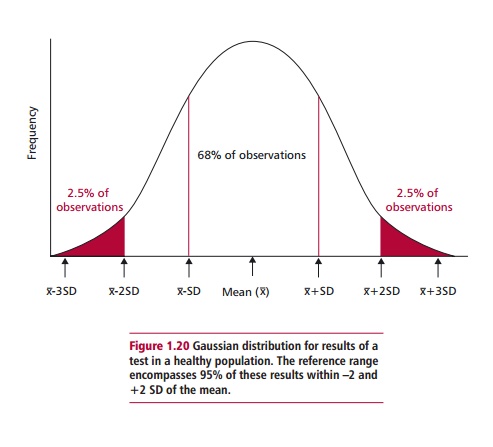Chapter: Biology of Disease: The Nature and Investigation of Diseases
Reference Ranges of Diseases
REFERENCE RANGES
Reference ranges were mentioned earlier. The
reference range for any particular analyte can be obtained by measuring it in
healthy individuals from a representative sample of the local population. Most
laboratories use healthy blood donors. It may be important to know the normal
range

in adults, children, males, females, particular
ethnic groups, or pregnant or postmenopausal women. However, since no
analytical method is 100% accurate and since individuals vary, care must be
taken when establishing a reference range. To determine the reference range,
the values for the measured analyte are plotted against their frequency in the
selected population. In most values clustered around the center as seen in Figure 1.20. The mean ( x ) and standard
deviation (SD) can be determined from these data.
In general, the reference range is taken to be
between two standard deviations either side of the mean. This will cover 95% of
the values obtained for the selected sample (provided the curve is Gaussian).
The 95% reference range was selected as this minimizes any overlap between the
results for a healthy population and those for a population with the disease.
However, choosing a 95% range is one of the major limitations of reference
ranges, since 5% of healthy individuals will, by definition, give results that
are outside these values. Thus a test result outside the reference range does
not necessarily imply that the individual is ill although it does indicate that
there is a greater likelihood of the presence of disease.
The profile of test results for some substances, for
example serum bilirubin, does not give a Gaussian curve but shows a skewed
distribution. This skewed distribution can be transformed mathematically to a
Gaussian distribution and a normalized reference range calculated.
The values of a number of analytes, such as serum
iron and alkaline phosphatase vary with the age or sex of the patient. In such
cases, age- and sex-matched reference ranges are required. When interpreting
results for a particular patient, the ideal reference value would be obtained
from the same patient before their illness and this is sometimes possible. For
example, the concentrations of electrolytes in serum can be measured in a
patient before an operation for comparison with those obtained postoperatively.
However, in most cases the results for the patient before they became ill are
not available.
Related Topics